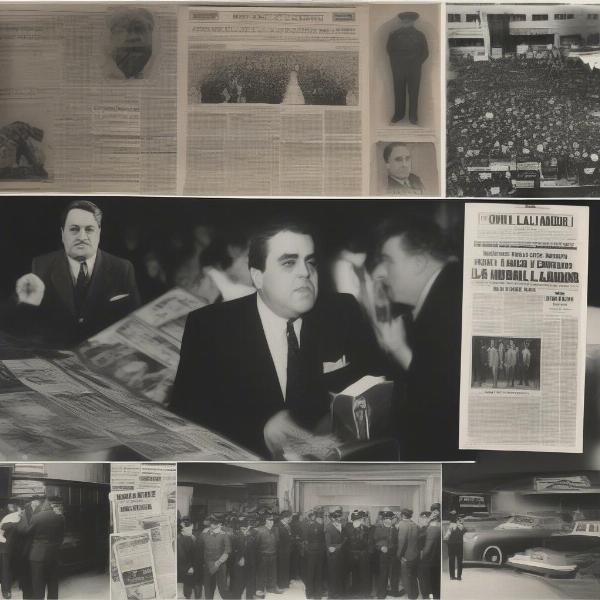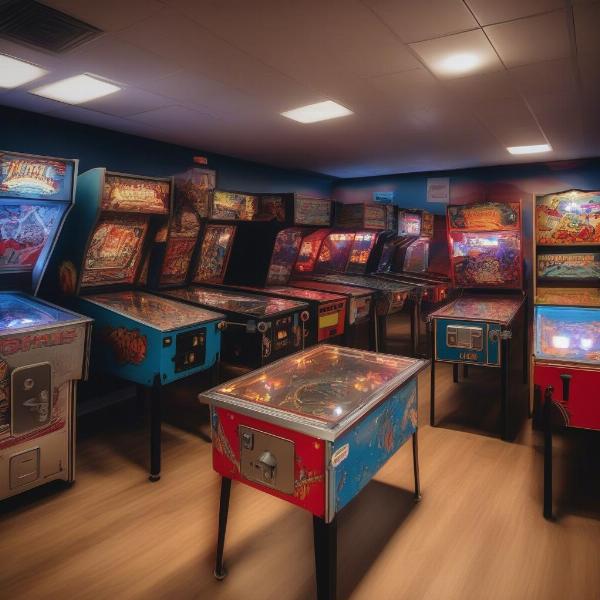Pinball, a game now synonymous with arcades and nostalgic entertainment, was once surprisingly illegal in New York City. For over three decades, this seemingly harmless game was banned, deemed a game of chance and a drain on the pockets of the city’s youth. This ban, lasting from the 1940s until the 1970s, shaped the history of pinball and its perception in American culture.
The Great Pinball Prohibition: A History
The ban on pinball in New York City wasn’t a sudden occurrence. It was the culmination of growing concerns about gambling and the perceived negative influence the game had on young people. Mayor Fiorello La Guardia, a prominent figure in New York City’s history, spearheaded the ban, believing pinball to be a “racket” that preyed on children and diverted money away from more productive activities. He saw it not as a game of skill, but as a game of chance, no different from other forms of gambling that he was actively trying to eradicate from the city.
The enforcement of the ban was aggressive. Police raids were common, with machines confiscated and often destroyed. Owners of establishments with pinball machines faced fines and even imprisonment. This period marked a dark age for pinball enthusiasts and businesses alike, driving the game underground and fueling a black market for pinball machines.
Why Was Pinball Considered Gambling?
The primary reason pinball was categorized as gambling stemmed from the fact that early machines often offered payouts. Winning scores triggered mechanisms that dispensed coins or awarded free games, blurring the lines between amusement and gambling. This association with monetary reward solidified the perception of pinball as a game of chance, further fueling La Guardia’s crusade against it.
The Fight to Legalize Pinball
Despite the ban, pinball maintained a dedicated following. Advocates argued that pinball was, in fact, a game of skill, requiring precise aim and timing to achieve high scores. This argument gained traction over the years, and efforts to overturn the ban slowly but surely gained momentum. Demonstrations and legal challenges chipped away at the prohibition, highlighting the absurdity of banning a game enjoyed by so many.
 Pinball Ban in New York City: Historical Photos and Newspaper Clippings
Pinball Ban in New York City: Historical Photos and Newspaper Clippings
The Flipper Changes Everything
The introduction of the flipper in the late 1940s revolutionized pinball. This simple addition transformed the game from one largely reliant on chance to one that required skill and strategy. Players now had direct control over the ball, allowing them to influence its trajectory and aim for specific targets. This development played a crucial role in shifting public perception and bolstering the argument for legalization.
Roger Sharpe’s Demonstration of Skill
One of the most pivotal moments in the fight for legalization came in 1976 when Roger Sharpe, a writer for GQ magazine, demonstrated the skill involved in pinball before the New York City Council. Sharpe called two specific shots on a pinball machine, proving that the game was not solely reliant on luck. This dramatic display helped convince the council that pinball was indeed a game of skill, paving the way for the ban to be lifted.
 Roger Sharpe Demonstrates Pinball Skill Before New York City Council
Roger Sharpe Demonstrates Pinball Skill Before New York City Council
The Aftermath of the Ban
The lifting of the ban in 1976 marked a new era for pinball in New York City. The game emerged from the shadows, regaining its rightful place in arcades and entertainment venues. The decades-long prohibition became a curious footnote in the city’s history, a testament to the changing perceptions of games and entertainment.
Pinball Today: A Resurgence of Popularity
While pinball’s popularity waned in the face of video games, it has experienced a resurgence in recent years. The game’s tactile nature and the strategic depth offered by modern machines have attracted a new generation of players. Pinball leagues and tournaments are thriving, demonstrating the enduring appeal of this classic game.
“The ban on pinball was a product of its time,” says fictional gaming historian Dr. Evelyn Reed, “reflecting anxieties about youth culture and gambling. It’s fascinating to see how the perception of the game evolved, ultimately recognizing its inherent skill and entertainment value.”
 Modern Pinball Machines and Arcades: A Revival
Modern Pinball Machines and Arcades: A Revival
The Legacy of a Banned Game
The story of pinball’s prohibition in New York City serves as a reminder of how societal perceptions of games and entertainment can shift over time. From being deemed a gambling menace to being recognized as a game of skill, pinball’s journey reflects broader cultural changes and the enduring appeal of a truly unique form of entertainment. What are your thoughts on this unusual piece of gaming history? Share your comments below!
Related Topics: The History of Arcades and Gaming
The ban on pinball is intertwined with the history of arcades and gaming in general. Understanding the evolution of entertainment venues and the societal responses to them provides valuable context for the pinball ban. Exploring the history of penny arcades, the rise of video games, and the ongoing debate about the impact of games on society can further illuminate the complexities of the pinball prohibition.
The Social Impact of Video Games
The rise of video games significantly impacted the popularity of pinball. Examining the social impact of video games, both positive and negative, can help understand the competitive landscape that pinball faced and continues to navigate. This includes the discussion surrounding video game addiction, the benefits of gaming communities, and the influence of esports.
Conclusion
The story of pinball’s prohibition in New York City is a compelling chapter in gaming history. From being outlawed as a game of chance to being celebrated for its skill-based gameplay, pinball’s journey highlights the changing social landscape and the enduring allure of this classic game. The next time you step up to a pinball machine, remember the unique history behind this seemingly simple game. Let us know in the comments if you remember the era of the pinball ban!
FAQ
-
When was pinball banned in New York City? The ban was enacted in the 1940s.
-
Who banned pinball? Mayor Fiorello La Guardia led the charge to ban pinball.
-
Why was pinball banned? It was considered a game of chance and a form of gambling.
-
When was the ban lifted? The ban was lifted in 1976.
-
What contributed to the lifting of the ban? The introduction of the flipper and Roger Sharpe’s demonstration of skill were key factors.
-
Is pinball still popular today? Pinball has experienced a resurgence in recent years.
-
Where can I play pinball? Many arcades and bars feature pinball machines.

